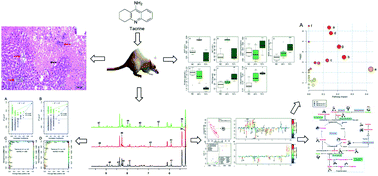The acute hepatotoxicity of tacrine explained by 1H NMR based metabolomic profiling
Abstract
Tacrine is a well-known acetylcholinesterase inhibitor used for the treatment of Alzheimer's disease (AD). Unfortunately, the occurrence of hepatotoxicities was found in about 30% of patients taking tacrine at its therapeutic doses, which severely limits its clinical use. The mechanism of its hepatotoxicity has not been fully elucidated. The purpose of this study was to develop and characterize a model of acute hepatotoxicity induced by tacrine to understand the mechanism by 1H NMR based metabolomics approach. Rats were first intraperitoneally injected with tacrine solution (11.89 mg per kg body weight). Histopathological inspections at 24 hours after treatment with tacrine disclosed severe liver damage. In addition, the activities of enzymes and the expressions of relevant genes were measured in this study. An orthogonal signal correction partial least-squares discriminant analysis (OSC-PLSDA) of the metabolomic profiles of rat liver tissues highlighted a number of metabolic disturbances induced by tacrine, focusing on energy metabolism and oxidative stress. These findings could well explain tacrine-induced acute hepatotoxicity and reveal several potential biomarkers associated with this toxicity. This integrated metabolomics approach demonstrated its feasibility and allowed a better understanding of tacrine-induced liver toxicity dynamically and holistically.

- This article is part of the themed collection: Alzheimer's Research Month 2016

 Please wait while we load your content...
Please wait while we load your content...